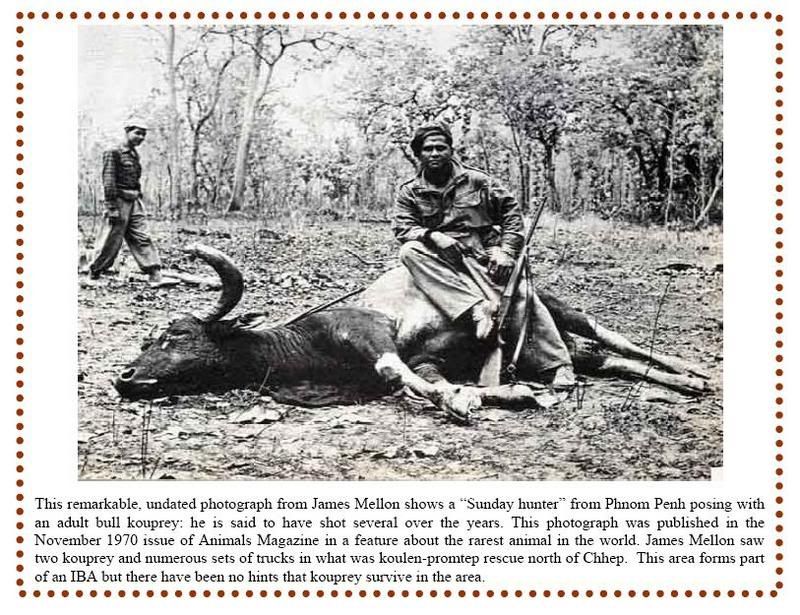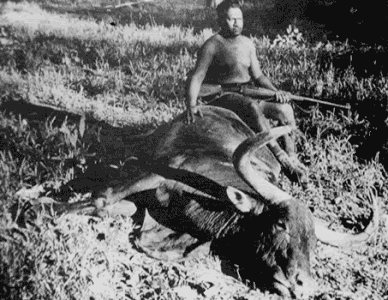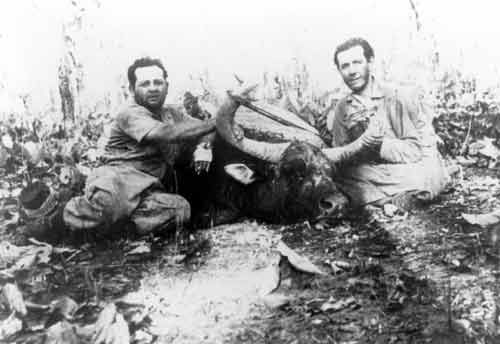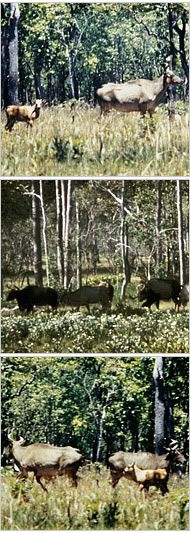A Celebrity Among Ungulates May Soon Be Dismissed
In the 1930's, the kouprey trotted like a revelation out of the forests of
central Indochina and into the world of modern science. Here, after all, was
a large wild ox with the speed and grace of a deer and an impressive set of
horns, yet it had been hiding in plain view, having never been officially
discovered by science.
But now, just 70 years after the first captive kouprey was sent to France
from Cambodia for study, the last species of wild Asian cattle to become
known scientifically may become the first to vanish in modern times - and
not necessarily through extinction. Rather, three biologists from
Northwestern University and the Cambodian Forestry Administration have
proposed a taxonomic demotion. In a paper published online in July by The
Journal of Zoology, they say the kouprey (koh-PRAY) is probably a domestic
hybrid that became feral, a zoological poseur, not a valid species.
The biologists' proposal has met stiff opposition within the small group of
scientists who study Asian wild cattle. Several say the paper misinterpreted
the genetics and history of the kouprey, which may still exist in
domesticated form. Although rare, elusive and enigmatic, kouprey are
recognizable enough, longer-legged, more graceful, faster and slightly
larger than the closely related banteng, and slightly smaller than the gaur,
the largest of the wild cattle.
Kouprey bulls stand just over six feet tall and weigh up to 1,800 pounds,
with a humpback, a dewlap - the loose fold of skin dangling from the neck -
that can drag the ground and elaborate curved horns. Females are about
three-quarters the size of males, have little or no dewlap, and their horns
spiral at the ends. Kouprey are probably extinct in the wild, victims of
overhunting, war and habitat loss. There have been no confirmed sightings in
more than 20 years, and even unconfirmed sightings have been rare since the
1990's. There are no kouprey in any of the world's zoos.
But if the kouprey is not a species, then the word "extinction" does not
have its usual meaning. Or as Gary J. Galbreath, the lead author of the
paper, put it in an e-mail message, "It is pleasant to realize that humans
have probably not, after all, caused the extinction of a species in this
case."
In their Journal of Zoology paper, Dr. Galbreath and his colleagues say the
kouprey most likely originated as a cross between two domesticated species,
the banteng and the zebu. Dr. Galbreath said in an interview that the animal
might have become wild in the 19th century as a result of the societal
disruption that followed an invasion of Cambodia by Thailand, then called
Siam. Although the kouprey reproduced in the wild, they were in decline
almost from the moment of their escape from domesticity.
The researchers say their conclusions are based on analysis of mitochondrial
DNA, or DNA inherited only from the mother, taken from two living Cambodian
banteng and from the taxidermic remains of that first captive kouprey
shipped to France in 1936.
Essentially, they found that the mitochondrial DNA sequence of the kouprey
matched that of the Cambodian banteng, indicating a common maternal
original. Anticipating criticism, Dr. Galbreath and his colleagues
considered two alternative interpretations. A vast genetic mixing hundreds
of thousands of years ago involving banteng and a zebu-like wild ox could
have produced the kouprey, they said, but that was unlikely because such
events were rare, and there was no evidence that the wild ox existed.
It is also possible the kouprey was a naturally occurring species whose
females, as its numbers declined, mated occasionally with banteng. But the
researchers doubt that could have produced two captive banteng with kouprey
mitochondria.
Here is the twist: in 2004, two French scientists, Alexandre Hassanin and
Anne Ropiquet of the National Museum of Natural History in Paris, sequenced
the taxidermic kouprey's DNA to show that the kouprey was a natural species,
not a hybrid. They posted the sequence in a public genetic data bank, where
it was available to Dr. Galbreath's team, which turned the French scientists
' conclusion on its head.
Dr. Hassanin and Dr. Ropiquet have fired back. In a recently submitted
paper, they argue hypothetically that if the Cambodian banteng represents a
separate species from the Javan banteng, then the kouprey could have derived
from the Cambodian version, as the Galbreath team proposes. But it was more
likely, Dr. Hassanin said in an e-mail message, that the kouprey was a
natural species that evolved in Southeast Asia. On at least one occasion
more than 100,000 years ago, a kouprey mated with a banteng. Their
descendants are Cambodia's banteng, with mitochondrial DNA more closely
resembling kouprey than banteng.
To complicate matters further, last February Dr. Hassanin and other
colleagues published a paper in the journal Comptes Rendus Biologies arguing
that a specimen mounted in 1871 in Paris and thought to be a domestic ox
from Indochina was, in fact, a domesticated kouprey. The specimen has been
at the museum in Bourges since 1931.
Dr. Hassanin said several indigenous Asian breeds of cattle might be derived
from kouprey. Herds, especially in Cambodia, should be tested to see whether
any are pure kouprey, Dr. Hassanin and his colleagues said, adding that if
they are, steps should be taken to preserve them.
Where Dr. Hassanin sees pure kouprey, Dr. Galbreath finds his banteng-zebu
hybrid. Independently, both say that more extensive sampling and analysis of
mainland banteng are needed to determine who is correct. Commenting on the
papers, Simon Hedges, an Asian cattle specialist with the Wildlife
Conservation Society who was not involved in either study, tended to agree
that the Cambodian banteng had probably hybridized with the kouprey. But he
also suggested that the kouprey both groups studied might itself have been a
banteng-kouprey cross.
"A key message to take out of this debate is that the same forces -
overhunting, war, habitat fragmentation and loss - that caused the likely
extinction of the kouprey are still at work on other species, such as the
banteng," Mr. Hedges said. "The challenge is to keep them from suffering the
same fate as the kouprey, whatever it was."





